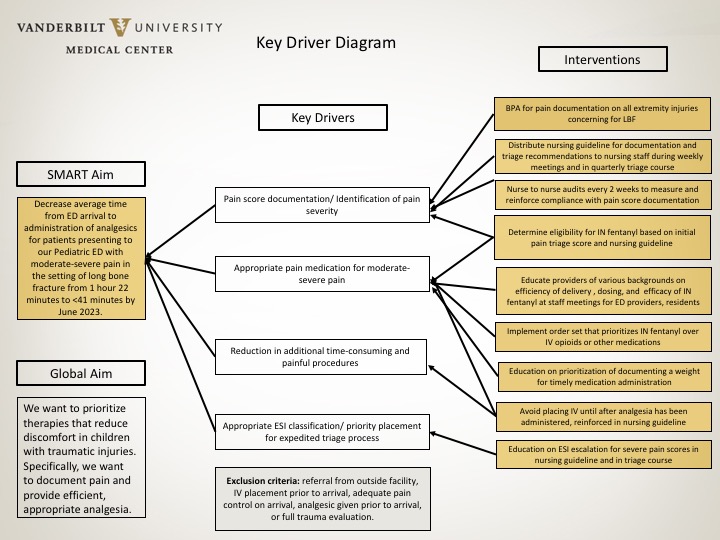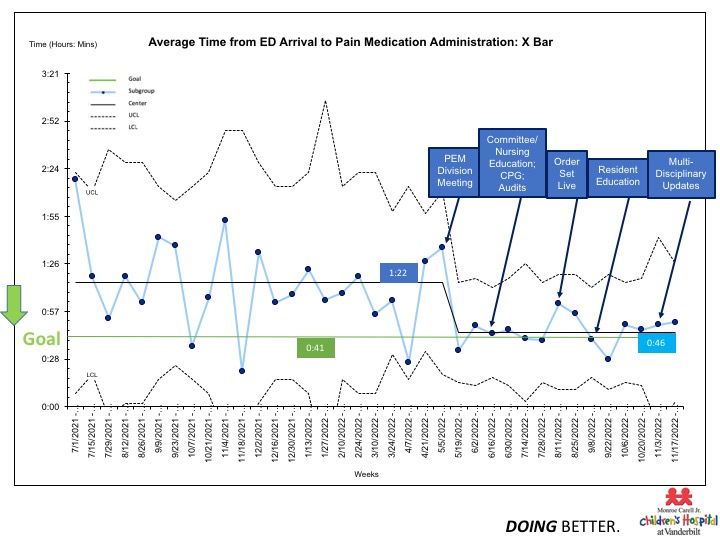Emergency Medicine: Quality Improvement
Emergency Medicine 5 B
342 - Improving Time to Analgesia in Patients with Long Bone Fractures in a Pediatric ED
Publication Number: 342.209
.jpg)
Jessica Hayes, MD
Resident Physician
Vanderbilt University Medical Center
Nashville, Tennessee, United States
Presenting Author(s)
Background:
Long bone fractures are the most common injury in the pediatric population. Analgesia is often delayed due to staffing, ED crowding delays, inefficient triage processes, underuse of pain assessment tools, and attempts at IV placement prior to giving analgesics.
Objective:
To decrease the average time from ED arrival to administration of analgesics for patients presenting to our Pediatric ED with moderate-severe pain in the setting of long bone fracture from 1 hour 22 minutes to < 41 minutes by June 2023.
Design/Methods:
A multidisciplinary team developed a key driver diagram (Figure 1). Retrospective baseline data were obtained from 7/1/21-4/30/22, after which data were followed prospectively. The population included all children ages 0-18 who presented to the ED with moderate-severe pain, as measured by a validated numeric pain score, and had a final diagnosis of long bone fracture. Data were extracted weekly from the electronic medical record. The primary outcome was average time from ED arrival to analgesic administration. Statistical process control charts were used to analyze data. Nelson rules were utilized to detect special cause variation. Process measures included percent of patients with IVs placed prior to analgesics, with pain scores documented prior to analgesics, and who received IN fentanyl on arrival. Balancing measures included percent of patients receiving non-opioids on arrival.
Results:
Of 295 total encounters, baseline data represented 165 encounters with an average time to pain medication administration of 1 hour 22 minutes. Following multidisciplinary education as well as clinical practice guideline and order set implementation, special cause variation was detected with a centerline shift to a new sustained average time of 46 minutes (Figure 2), which was sustained for 7 months. The percent of encounters in which IVs were placed prior to analgesic administration decreased from 18% to 5%. Pain score documentation prior to analgesics improved from 53% to 58%. Percent of patients in moderate-severe pain who received IN fentanyl on arrival increased from 22% to 30% and who received a non-opioid on arrival increased from 59% to 65%.
Conclusion(s):
We reduced the time from ED arrival to analgesic administration from 1 hour 22 minutes to 46 minutes, sustained over 7 months. While a greater percentage of patients in significant pain initially received non-opioids, there was a shift away from IV placement before analgesia was achieved. Ongoing efforts are focused on best practice advisory alerts and multidisciplinary reviews of performance with focused feedback to clinicians.

